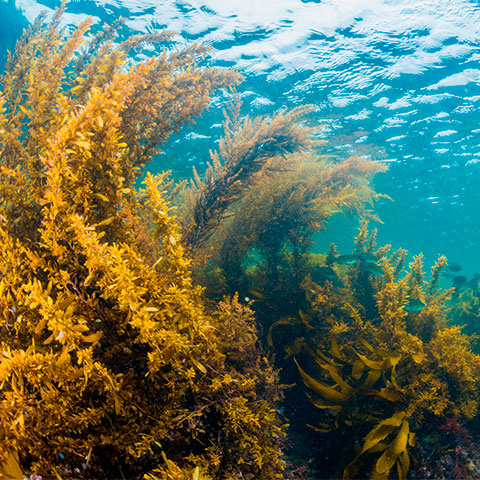
Algae are authentic sea vegetables, and have the same natural cycles as terrestrial plants.
Algae feed on sunlight and can be found at sea level or in the deep sea, forming large marine forests.
Interestingly, the Chinese, Japanese and Thai / and Asian population, in general, continues to maintain the inclusion of algae in their diet and cuisine, while, in Spain, specifically, although we have extensive coasts and abundant forests of Seaweed, there is no manifest interest in the inclusion of seaweed in our diet, despite the enormous benefits that are being attributed to them.
Various studies on the biology of algae attribute to them antioxidant, anti-inflammatory and antibacterial properties, so that they are considered as an abundant resource of bioactive molecules, and an infinite source of beneficial properties for health.
What are the most common uses of Algae
In addition to their use in the kitchen, they have multiple uses.
 For example, most of the collected algae are used as thickeners, as stabilizers and, especially, as gelling products, appearing in many applications of the food industry, in household items and in biomedical products.
For example, most of the collected algae are used as thickeners, as stabilizers and, especially, as gelling products, appearing in many applications of the food industry, in household items and in biomedical products.
Consequently, we would be surprised to know that we have been (without even knowing) a long time using seaweed in cosmetics, shampoos, toothpaste, animal feed, baby food, milk products, instant soups, sausage coating, and many other products that possess the preservatives -additives- E-406, E-401, E-402, E-403 and E-404. This gives us a clear idea that algae are part of our daily lives and that we didn’t even know it.
Paradoxically, Spain is the world’s second largest producer of AGAR, which is obtained from algae and has so many uses in many areas. For authors such as Rupérez, Gómez-Ordóñez and Jiménez-Escrig (2011), some of these uses would be:
- Seaweed meal: obtained from dried seaweed that is subsequently ground.
- Fertilizers: use of brown algae, rich in minerals and trace elements, which would nourish the agricultural soil. In addition, thanks to its fiber content, they would contribute to water retention, providing plants with a higher level of moisture. Since, at present, organic agriculture is booming, the industry that makes fertilizers is using algae to a large extent, thanks to its natural properties.
- Cosmetics: In a large number of cosmetic products, the “marine extract” or “seaweed extract” can be observed in its composition, due to the large capacity of a hydrocolloid extracted from algae (such as alginate or carrageenan) ) to retain water.
- Fuels: In recent years, research and application of the use of algae as an indirect fuel source has been extended. This is possible because the algae come to ferment, and this would form the biomass that generates methane gas, which would be used as fuel. The results of numerous studies on the use of algae for fuel generation indicate that the use of algae as a source of energy could be feasible, although research and development must continue to be encouraged so that in the future they can be economical.
- Wastewater treatment: Currently, there is a tremendously interesting new open research nucleus: it seems that some algae can absorb heavy metal ions from contaminated water, such as zinc and cadmium, something that is still under study , but it seems that it will become a reality in the near future.
- Antiviral agents: an antiviral activity has been reported in the extracts of some algae, although the tests carried out have been in vitro or in animals, and there has been little progress in the trials with people. For example, there are now indications that Carraguard (which is a mixture of carrageenans) is effective against HIV in vitro and against herpes simplex virus-2 in animals.
The Classification of Algae according to their Pigments
There are algae so simple that they are reduced to a single cell, others instead are among the largest plants in the world, hundreds of meters. Almost 24,000 species of algae are known, and a way of classifying them according to the type of pigment they possess and which gives them their characteristic appearance:
- Green algae (Chlorophyll): They are characterized by being green due to their abundance of chlorophyll.
- Brown or brown algae (Feofíceas): they are brown or brown due to the presence of fucoxanthin.
- Red algae (rhodophyceae): red algae due to the phycoerythrin pigment.
- Bluish algae (Cyanophyceae): They are characterized by being bluish algae or due to the presence of the phycocyanin pigment.
Brown algae are usually large and can reach 20 meters in length and up to 2 meters in width, such as Cochayuyo seaweed. Red algae are usually smaller and usually measure about 1 meter in length.
Green algae are also small, and like red algae, they usually measure about 1 meter in length. All of them are of fundamentally agricultural interest, in human food, in pharmacology and cosmetics, and in environmental regeneration systems for effluent purification (La Barre, S., Potin, P., Leblanc, C. and Delage, L. , 2010).
We see, then, how seaweeds are important in the food chain, and an interesting source of resources in human nutrition, and as we have just seen, they are also useful as fertilizers and for the manufacture of animal feed, all of them more reasons that enough to stimulate their knowledge and consumption.
Without forgetting, of course, its great benefits (an aspect that we will discuss next in an upcoming article) and that will convince us even more of its use. Why not try them?
References
Batista, A. E., Charles, M. B., Mancini-Filho, J. and Vidal, A. (2009). Seaweed as sources of antioxidant phytopharmaceuticals. Cuban magazine of medicinal plants, 14 (2), 204-228.
La Barre, S., Potin, P., Leblanc, C. and Delage, L. (2010). The halogenated metabolism of brown algae (phaeophyta), its biological importance and its environmental significance. Marine Drugs, 8 (4), 988-1010.
Rupérez P, Gómez-Ordónez E. and Jiménez-Escrig A. (2011). Nutritional quality and biological properties of brown and red edible seaweeds. In V.H. Pomin (Ed.), Seaweed: Ecology, Nutrient Composition and Medicinal Uses, pp 51-66. Chapter 3. Series: Marine Biology. Earth Sciences in the 21st Century. Nova Science Pub. Inc., Hauppauge, New York, USA. ISBN: 978-1-61470-878-0



